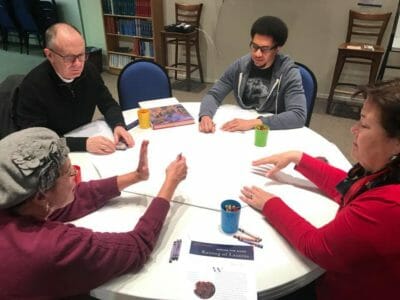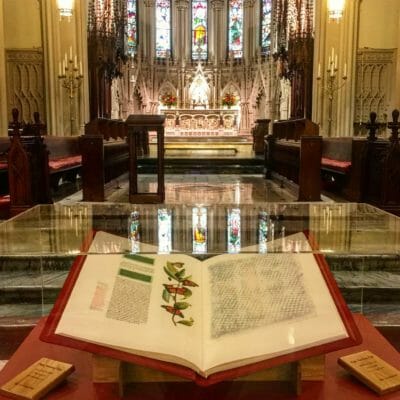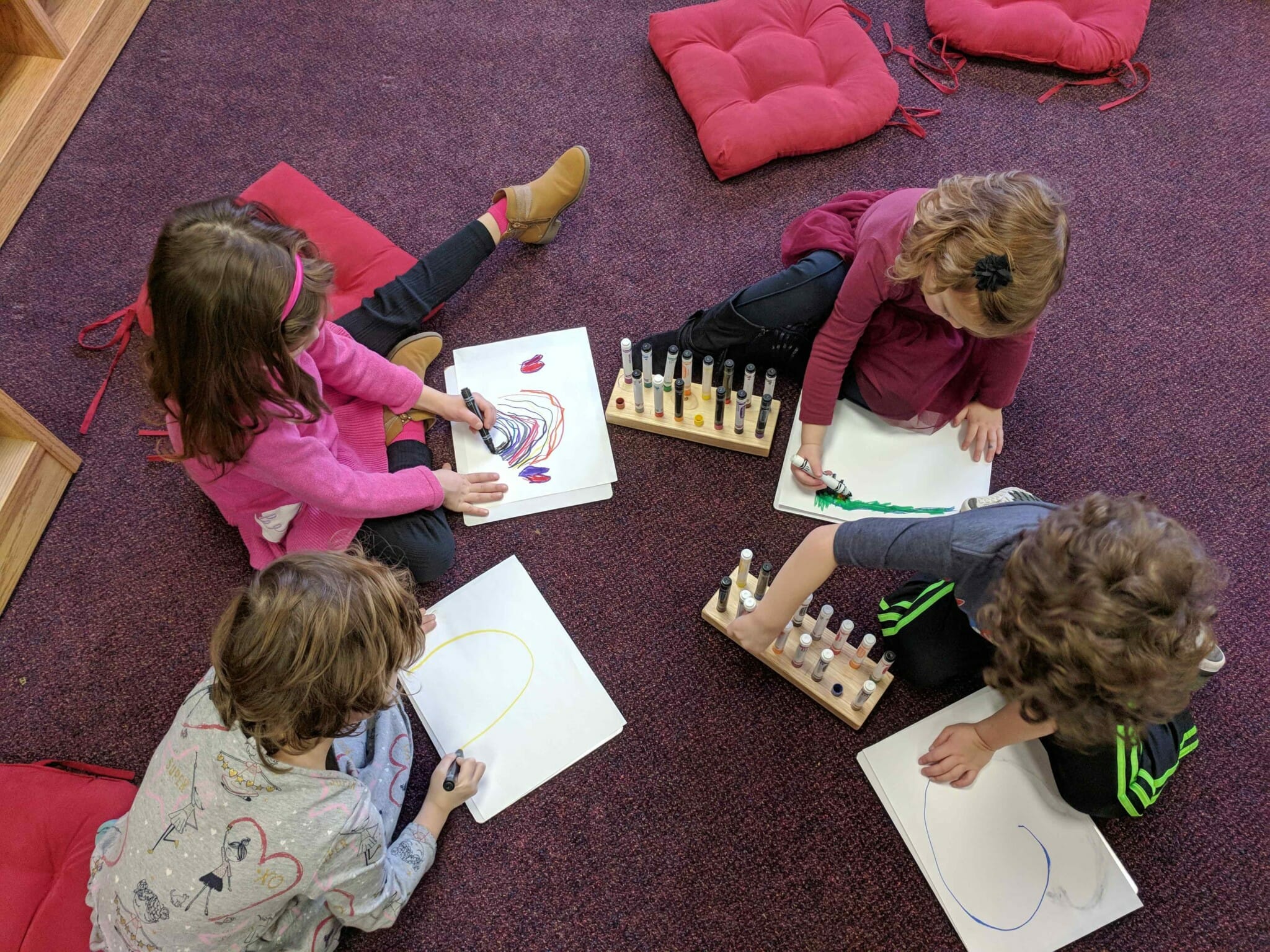The Cathedral of the Incarnation Envisions the Future of Faith through the Heritage Edition
Heritage Edition helps connect art, faith and creativity in Long Island community
The Cathedral of the Incarnation in Garden City, New York, was founded in 1885 and is listed on the National Register of Historic Places. With impressive Gothic architecture, stained glass windows and a 200-foot spire, the cathedral is the centerpiece of Garden City. Its staff feels a responsibility to make it “a house of prayer for all of Long Island,” said Kristin Vieira, administrator and assistant to the dean of the cathedral, the Very Rev. Michael Sniffen. In that light, hosting the The Saint John’s Bible has been just the latest effort by the cathedral in its more than 130-year history of community building.
The Bible first came to the cathedral’s attention at the 2017 Consortium of Endowed Episcopal Parishes (CEEP) Conference, where Dean Sniffen attended an event to learn about the project. “He was really inspired,” said Vieira. “He brought back the coffee table version and we looked through them and I thought, ‘We can build a program around this.’ We love connecting art and faith and inspiring creativity in the congregation, so it seemed like this was the perfect match.”
Planning for Community Impact
The cathedral spent the summer of 2017 planning their Year with The Saint John’s Bible, and also sent a team to Saint John’s University to see the original Bible and learn about the project firsthand. During the planning phase, cathedral staff also thought carefully about how to keep the Bible accessible to visitors, no matter what day of the week. “We’re lucky to have such a beautiful space, and we keep our doors open all week so people can just come in,” said Vieira. “We really want people to feel welcome to just wander in to pray and reflect, and we wanted the Bible to be a part of that.”
 The cathedral’s community – the actual people Vieira hoped would “wander in” – was influential in deciding how the cathedral would approach presenting their copy of The Saint John’s Bible. “The congregation is unique in a suburban context,” explained Dean Sniffen. “It serves the communities of Long Island, which include the most diverse urban neighborhoods in the world (Brooklyn and Queens) and some of the most segregated suburbs in the nation (Suffolk and Nassau Counties). One of the great gifts of ministry at the cathedral is bringing people together for inspiration across all kinds of diversity. The Saint John’s Bible does this beautifully.”
The cathedral’s community – the actual people Vieira hoped would “wander in” – was influential in deciding how the cathedral would approach presenting their copy of The Saint John’s Bible. “The congregation is unique in a suburban context,” explained Dean Sniffen. “It serves the communities of Long Island, which include the most diverse urban neighborhoods in the world (Brooklyn and Queens) and some of the most segregated suburbs in the nation (Suffolk and Nassau Counties). One of the great gifts of ministry at the cathedral is bringing people together for inspiration across all kinds of diversity. The Saint John’s Bible does this beautifully.”
Vieira added that with that diversity of backgrounds comes diversity of thought around the Bible. “One of the things I love about The Saint John’s Bible is that you can appreciate what someone else sees in it and know that what you see in it is meaningful, too. It’s a really important way to teach young people how to look at the Bible – that there are many different interpretations and to welcome that. It’s not something to be afraid of.”
With its team trained and a custom display table made for the Bible, the cathedral began hosting the Heritage Edition in November. Finally having the Bible on the premises gave the team a chance to show the community what was so special about it – a point that may not be obvious to the uninitiated.
“I called a reporter from our newspaper to see if he wanted to come out and do a story on it, and his initial response was, ‘An illuminated Bible? So what? There’s a bunch of those,’” said Vieira. “We learned that explaining why The Saint John’s Bible is so unique – why it’s an old style of creating a Bible but it’s very modern, very new, very of its time – figuring out how to express that to people was really important.” (Vieira eventually succeeded in her efforts with the reporter, whose resulting article called the Bible “a marvel.”)
Programming for New Ways of Looking at Faith
The cathedral planned two key events for its program year: For its launch event, it hosted Tim Ternes, director of The Saint John’s Bible at the Hill Museum & Manuscript Library. Ternes led both an ecumenical workshop for clergy members as well as an introduction of the Bible to the general public. In the spring, Dr. Anton Koekemoer, a Hubble Astronomer at the Space Telescope Science Institute, gave a presentation titled, “Faith and Science in Harmony: Creation, Science and The Saint John’s Bible,” discussing modern astronomical discoveries with a special focus on the Hubble images that were used in the Bible’s illuminations.
 “Dr. Koekemoer’s talk appealed not only to people from different faiths, but people who weren’t necessarily religious at all,” said Vieira. “He did such a great job of connecting science and faith, and not viewing that as a dichotomy but as two ways of looking at something.”
“Dr. Koekemoer’s talk appealed not only to people from different faiths, but people who weren’t necessarily religious at all,” said Vieira. “He did such a great job of connecting science and faith, and not viewing that as a dichotomy but as two ways of looking at something.”
In addition to the presentations by Tim Ternes and Dr. Koekemoer, the cathedral also held Advent and Lenten programming series, including an opportunity for attendees to create their own artwork inspired by the art of The Saint John’s Bible.
“Adults don’t usually get to draw, and they had such a great time,” said Vieira. “It just encouraged people to be really playful. For them to be able to be creative and remember that we are all creative beings was a really great moment.”
Imagining Faith in the Future
The Saint John’s Bible has inspired connections outside of the cathedral as well. The Garden City Clergy Fellowship, a local ecumenical group of faith leaders, drew on the Bible to design their program year, holding discussions on scripture and the arts, and inviting Muslim and Jewish scribes to demonstrate their work alongside the Bible. The cathedral team also traveled with the Bible to additional Episcopal churches within the Diocese of Long Island.
Having recently concluded its program year, the cathedral has announced plans to enter into a second year with the Heritage Edition. The team is planning a new theme of “Faith in the Future,” using Volume VII, Letters & Revelation.
“It will be really great in helping us look at how Christians viewed the future in Revelation,” said Vieira. “We’re going to be thinking about what the church will look like in 10, 20 or 100 years. We’re really going to spend some time thinking about spiritual imagination, and using our creativity and our imagination as a community.”
Vieira is excited for the ecumenical discussions to continue, and believes that the cathedral’s next year of programming will help them continue to build community bonds. “I think that in the future, it’s not going to be about being siloed in your individual way of doing things,” she said. “We celebrate the individual way that we worship and we’re definitely proud to be the Episcopal church, but we’re also all connected and we can all learn from and be inspired by each other. That’s what The Saint John’s Bible has communicated to us and what we need to communicate to the people in our community.”


